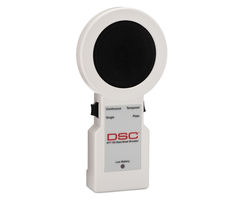Last week, we took a look at three of the best alarm panels in the industry. These were the Honeywell Lyric, the Qolsys IQ Panel 2 Plus, and the 2GIG GC3e. Today, we are checking out the sensors that you can add to support these systems. Here is our 2020 Security Sensor Buying Guide!

Sensors are accessories that are added to alarm systems to report specific activity. Each sensor has its own job of looking for a certain type of activity in its designated location. All of the sensors on a system communicate with a single centralized panel or hub. This panel is actively listening for any sensor that is triggered due to a potentially important system event. Adding new sensors is perhaps the best way to expand upon an existing system, and they make awesome gifts and stocking stuffers for the security enthusiast in your life.
Broadly speaking, sensors can be split into two main categories, which are security and life safety/environmental. Security sensors look for activity that suggests potentially unauthorized entry into a monitored and protected location, such as a door being opened, movement in a room where nobody is supposed to be present, or a window being broken. Life safety/environmental sensors look for activity associated with unwanted or potentially harmful conditions that affect the well-being of those in the area, such as a flood, an extreme temperature, a fire, or the presence of CO gas. We'll be taking a look at life safety/environmental sensors another time. Today, our focus is on security sensors.
Wireless Sensor Basics

Before we dive into specific security sensors for our top panel picks, we're going to start by giving you some general, generic information that can be applied to any sensor out there. First, understand that this post is focusing only on wireless sensors. These are almost always the sensors chosen for use with wireless alarm systems. Wired sensors can also technically be used with wireless panels but a converter module is almost always needed. Not to mention the fact that wireless sensors are significantly easier to install, especially for DIY users. The only time you will realistically see wired sensors used with a wireless panel is if a user is upgrading from an older wired system and bringing over their old wired sensors, or in new construction where a user wants to integrate the sensors in with the building. But if you're expanding upon a wireless system by getting new sensors, then the new sensors will almost certainly be wireless.
The important thing to remember when choosing wireless sensors for a wireless alarm panel is making sure the sensor is compatible with the system. It doesn't matter if a sensor has all the specs and features if it doesn't work with your panel! The way to determine compatibility is to look at the lineup that the sensor is from. Petty much every wireless sensor out there is part of a larger grouping of sensors that will all have the same compatibility.
To make it easier for you, we have the three panels we mentioned before (well, make that five, as the Qolsys IQ Panel 2 Plus actually comes in three versions), and all their compatible sensor lineups conveniently listed. We hope that this sheds some light on your options. The only caveat is that for any panel listed here that supports the Honeywell 5800 Sensors, we must be clear that this is only for the uni-directional sensors with one-way communication in the lineup. Any bi-directional Honeywell 5800 Sensors with two-way communication will not work with any of the aforementioned systems. The bi-directional Honeywell 5800 Sensors are only compatible with the Honeywell LYNX Touch and VISTA Systems, which were not included in our buying guides.
With that out of the way, here are compatible sensor lineups by system:
-
Honeywell Lyric - Honeywell SiX Series, Honeywell 5800 Series, 2GIG 345 MHz Series
- 2GIG GC3e - 2GIG eSeries Encrypted Sensors, 2GIG 345 MHz Series, Honeywell 5800 Series
- Qolsys IQ Panel 2 Plus 319.5 MHz - DSC PowerG Sensors, Qolsys S-Line Sensors, Qolsys Legacy 319.5 MHz Sensors, Legacy Interlogix Sensors, Legacy GE Sensors
- Qolsys IQ Panel 2 Plus 345 MHz - DSC PowerG Sensors, Honeywell 5800 Sensors, 2GIG 345 MHz Sensors
- Qolsys IQ Panel 2 Plus 433 MHz - DSC PowerG Sensors, Legacy DSC 433 MHZ Sensors
You will notice that some of the sensor groups listed above are italicized and underlined. That is done to identify the lineups of encrypted sensors. These encrypted sensors have special protection measures put in place to make them more secure and less prone to being hacked or defeated by malicious attacks. Encrypted sensors tend to have more restricted compatibility. They may follow a special enrollment process. Encrypted sensors often use bi-directional communication so that the sensor knows that it is actively paired with the system. Many encrypted sensors may only be paired with a single system at any given time, and the sensor will need to be deleted from its existing system before it will work with a new one.
It's okay to use non-encrypted sensors with your system, especially in zones that are less likely to trigger an alarm, like a second story window. Many users will opt to use a mixture of both encrypted and non-encrypted sensors. Other users feel comfortable using entirely non-encrypted sensors. It really comes down to your level of comfort. Non-encrypted sensors are secure in most situations, and they are still tricky to defeat. But going fully encrypted is recommended for anyone seeking maximum security. One tip if you do decide to go with some non-encrypted sensors is to avoid letting others know what wireless frequency your sensors use or what type of system you have installed. Knowing the frequency and the system being used makes it much easier for a savvy intruder to defeat a sensor.
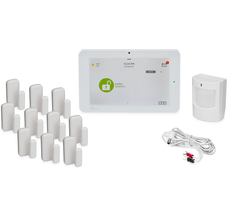
 Now that you know some basics that apply to almost all wireless sensors, let's start talking about specific types and models. Door and window sensors will let a system know when a door or window has been opened or closed. These are some of the most basic and easy to use sensors on a security system. These devices work by using a larger sensor portion and a smaller magnet portion. The sensor is placed on or inside the door or window frame, and the magnet is placed on or inside the moving portion of the door or window. When the door or window is opened, the magnet will move away from the sensor. This will trip a metal reed switch inside the sensor, which will tell the sensor to alert the system to the opened door or window. All of the sensors we've listed here follow that same method of operation.
Now that you know some basics that apply to almost all wireless sensors, let's start talking about specific types and models. Door and window sensors will let a system know when a door or window has been opened or closed. These are some of the most basic and easy to use sensors on a security system. These devices work by using a larger sensor portion and a smaller magnet portion. The sensor is placed on or inside the door or window frame, and the magnet is placed on or inside the moving portion of the door or window. When the door or window is opened, the magnet will move away from the sensor. This will trip a metal reed switch inside the sensor, which will tell the sensor to alert the system to the opened door or window. All of the sensors we've listed here follow that same method of operation.
Door and window sensors can be split into two (2) main categories. Surface-mount door and window sensors are mounted outside the door or window and its accompanying frame on the surface. The advantage to surface-mount door and window sensors is that they are very easy to install, and they can usually be mounted using double sided foam tape. But some users may not like how they are visible on the outside of the door or window. If you don't like the appearance of visible surface-mount door and window sensors, then you might instead consider recessed door and window sensors. A recessed door or window sensor is installed inside a door or window and its frame, so that it is hidden and cannot be seen from the outside. Recessed door and window sensors are more difficult and time-consuming to install, because you must drill holes in both the door or window and its accompanying frame. Whether you decide to use surface-mount door and window sensors, or recessed door and window sensors is up to you. Most DIY users and Alarm Grid customers in general will use surface-mount door and window sensors.
Now let's look at some door and window sensors.:
Sensor Name
|
Product Lineup
|
Compatibility
|
Range
|
Encryption
|
Installation
|
Notes
|
Honeywell SiXMINICT

|
Honeywell SiX Series
|
Lyric
|
200 Nominal Feet
|
128-bit AES
|
Surface-Mount
|
Premier mini encrypted door/window Sensor for Lyric.
|
DSC PG9303
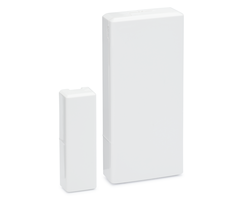
|
PowerG
|
All IQ Panel 2 Plus
|
2,000 Feet Open Air
|
128-bit AES
|
Surface-Mount
|
PowerG encrypted surface mount door/window sensor.
|
DSC PG9307

|
PowerG
|
All IQ Panel 2 Plus
|
2,000 Feet Open Air
|
128-bit AES
|
Recessed
|
PowerG encrypted recessed door/window sensor.
|
2GIG DW10e

|
2GIG eSeries
|
2GIG GC3e
|
350 Nominal Feet
|
2GIG eSeries Encryption
|
Surface-Mount
|
Encrypted surface-mount sensor for 2GIG
|
2GIG DW20e

|
2GIG eSeries
|
2GIG GC3e
|
350 Nominal Feet
|
2GIG eSeries Encryption
|
Recessed
|
Encrypted recessed sensor for 2GIG
|
Qolsys IQ DW Mini-S

|
Qolsys S-Line
|
319.5 MHz IQ2+
|
600 Feet Open Air
|
Qolsys S-Line Encryption
|
Surface-Mount
|
Encrypted surface-mount sensor for 319.5 MHz systems.
|
Qolsys IQ Recessed Door-S
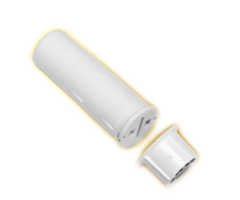
|
Qolsys S-Line
|
319.5 MHz IQ 2+
|
600 Feet Open Air
|
Qolsys S-Line Encryption
|
Recessed
|
Encrypted recessed sensor for 319.5 MHz systems.
|
Honeywell 5818MNL

|
Honeywell
5800 Series
|
Lyric, GC3e, 345 MHz IQ2+
|
200 Nominal Feet
|
None
|
Recessed
|
Non-Encrypted recessed door/window sensor for 345 MHz systems.
|
VERSA-2GIG

|
2GIG 345 MHz
|
Lyric, GC3e, 345 MHz IQ2+
|
200 Nominal Feet
|
None
|
Surface-Mount
|
Non-encrypted surface-mount sensor for 345 MHz systems.
|
VERSA-GE

|
Legacy GE
|
319.5 MHz IQ2+
|
200 Nominal Feet
|
None
|
Surface-Mount
|
Non-encrypted surface-mount sensor for 319.5 MHz systems.
|
VERSA-DSC
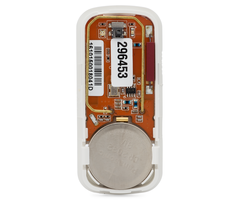
|
Legacy DSC
|
433 MHz IQ2+
|
200 Nominal Feet
|
None
|
Surface-Mount
|
Non-encrypted surface-mount sensor for 433 MHz systems.
|
We also want to share a selection of outdoor door and window sensors with you. These surface-mount contact sensors are specifically designed to withstand the conditions of an outdoor environment, including intense rain, wind, dust, and sunlight. You can see them listed below.
Sensor Name
|
Product Lineup
|
Compatibility
|
Range
|
Encryption
|
Installation
|
Notes
|
Honeywell 5816OD

|
Honeywell 5800 Series
|
Lyric, GC3e, 345 MHz IQ2+
|
200 Nominal Feet
|
None
|
Surface-Mount
|
Outdoor contact sensor from 5800 Series.
|
DSC PG9312

|
PowerG
|
All IQ Panel 2 Plus
|
2,000 Feet Open Air
|
128-bit AES
|
Surface-Mount
|
PowerG Outdoor Contact Sensor.
|
2GIG DW30-345

|
2GIG 345 MHz
|
Lyric, GC3e, 345 MHz IQ2+
|
350 Nominal Feet
|
None
|
Surface-Mount
|
Outdoor contact sensor from 2GIG 345 MHz series.
|

Motion sensors use passive infrared (PIR) technology to detect movement within the sensor's coverage area. This is done by looking for the changes in infrared (IR) energy that occur when a person, animal, or object comes within the sensor's field of view. Standard motion sensors are typically PIR only. These are appropriately called PIR motion sensors.
Some motion sensors will also use microwave technology in addition to PIR technology. This involves having the sensor send out microwave signals and seeing how the signals bounce off of objects in the area. Movement will change the pattern of these microwave signals, and the sensor will be able to detect this. These motion sensors that use both microwave and PIR are called Dual-Tech motion sensors. The purpose of using both PIR and microwave together is to prevent false alarms. A Dual-Tech motion sensor will only activate and alert the system if both its PIR sensor and its microwave sensor are triggered. A microwave sensor is not vulnerable to the same environmental issues that may cause a false activation on a PIR. You will not find a motion sensor that uses microwave technology without PIR detection, as microwave alone would result in too many false alarms without having PIR to confirm movement.
One feature that you will often see listed on a motion sensor is pet-immunity. A motion sensor that has been set up for pet immunity can be configured to not "look" in the areas close to the ground where pets and small animals walk. Instead, the motion sensor only looks in the areas higher up, where humans move while walking upright. A pet immune motion sensor is not impervious to small animals, and you must position it carefully so that it works as intended. Pet immune motion sensors normally have a weight limit, where animals under that weight limit should avoid triggering the sensor, assuming that the sensor is installed properly. Please note that most pet friendly motion sensors will require you to set the sensitivity for the sensor to the lowest possible setting.
When it comes to motion sensors, mounting them carefully is very important. A motion sensor may cause false alarms on the system if it is not installed properly. These sensors should not be facing any vents, air ducts, ceiling fans, or curtains that may cause the sensor to activate without any movement. If you are using the motion sensor for pet immunity, then it should also not be facing any furniture or stairwells that your pet could use to get within the sensor's field of view. You will likely want to perform a Walk Test of your motion sensor to make sure that it responds properly when movement is present, and does not respond due to other external factors when there is no movement. You should also have any pets participate in the Walk Test to ensure that pet immunity is working properly.
We recommend reading the following FAQs to learn more about motion sensors:
Below are some of the most popular motion sensors for our recommended systems:
|
Sensor Name
|
Product Lineup
|
Compatibility
|
Range
|
Encryption
|
Coverage Area
|
Detection Type
|
Pet Immunity
|
Notes
|
Honeywell SiXPIR

|
Honeywell SiX Series
|
Lyric
|
300 Nominal Feet
|
128-bit AES
|
40 by 56 Feet
|
PIR
|
Up to 80 lbs
|
Encrypted PIR Motion for Lyric.
|
DSC PG9914
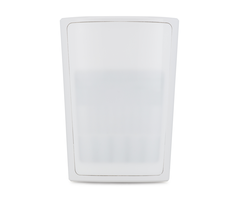
|
PowerG
|
All IQ Panel 2 Plus
|
2,000 Feet Open Air
|
128-bit AES
|
Up to 39 Feet
|
PIR
|
Up to 85 lbs
|
PowerG Encrypted PIR Motion.
|
DSC PG9984P

|
PowerG
|
All IQ Panel 2 Plus
|
2,000 Feet Open Air
|
128-bit AES
|
Up to 50 Feet
|
Dual-Tech
|
Up to 40 lbs
|
PowerG Encrypted Dual-Tech Motion.
|
2GIG PIR1e

|
2GIG eSeries
|
2GIG GC3e
|
350 Nominal Feet
|
2GIG eSeries Encryption
|
30 by 50 Feet
|
PIR
|
Up to 55 lbs
|
Encrypted PIR Motion for 2GIG.
|
Honeywell 5800PIR-RES

|
Honeywell 5800 Series
|
Lyric, GC3e, 345 MHz IQ2+
|
200 Nominal Feet
|
None
|
35 by 40 Feet
|
PIR
|
Up to 80 lbs
|
Non-encrypted residential PIR motion for 345 MHz systems.
|
Honeywell 5800PIR-COM

|
Honeywell 5800 Series
|
Lyric, GC3e, 345 MHz, IQ2+
|
200 Nominal Feet
|
None
|
60 by 80 Feet
|
PIR
|
None
|
Non-encrypted commercial PIR motion for 345 MHz systems.
|
Honeywell 5898

|
Honeywell 5800 Series
|
Lyric, GC3e, 345 MHz IQ2+
|
200 Nominal Feet
|
None
|
35 by 40 Feet for Pet Immunity
|
Dual-Tech
|
Up to 100 lbs
|
Non-encrypted Dual-Tech motion for 345 MHz systems.
|
Qolsys IQ Motion-S

|
Qolsys S-Line
|
319.5 MHz IQ2+
|
600 Feet Open Air
|
Qolsys S-Line Encryption
|
30 by 40 Feet
|
PIR
|
Up to 40 lbs
|
Non-encrypted PIR motion for 319.5 MHz systems.
|
There are also certain outdoor motion detection sensors that are better-suited for use in an outdoor environment. These outdoor motion sensor models are typically more expensive than indoor variants. You can see some of our most popular ones listed below:
Sensor Name
|
Product Lineup
|
Compatibility
|
Range
|
Encryption
|
Coverage Area
|
Detection Type
|
Pet Immunity
|
Notes
|
DSC PG9994

|
PowerG
|
All IQ Panel 2 Plus
|
2,000 Feet Open Air
|
128-bit AES
|
Up to 30 Feet
|
PIR
|
Up to 40 lbs
|
PowerG Outdoor PIR Motion Sensor
|
Honeywell 5800PIR-OD
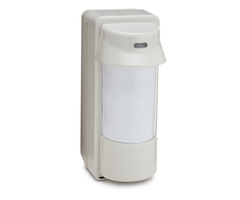
|
Honeywell 5800 Series
|
Lyric, GC3e, 345 MHz IQ2+
|
200 Nominal Feet
|
None
|
40 by 30 Feet
|
PIR
|
None
|
Honeywell 5800 Series Outdoor Motion, 1st ed.
|
Honeywell 5800PIR-OD2

|
Honeywell 5800 Series
|
Lyric, GC3e, 345 MHz IQ2+
|
200 Nominal Feet
|
None
|
40 by 30 Feet
|
PIR
|
None
|
Honeywell 5800 Series Outdoor Motion, 2nd ed.
|
Optex FTN-RRIX

|
Legacy Interlogix
|
319.5 MHz IQ2+
|
200 Nominal Feet
|
None
|
Up to 16.5 Feet
|
PIR
|
None
|
Optex Fitlink Outdoor Motion Sensor for 319.5 MHz Systems
|
Optex FTN-RR2G

|
2GIG 345 MHz
|
Lyric, GC3e, 345 MHz IQ2+
|
200 Nominal Feet
|
None
|
Up to 16.5 Feet
|
PIR
|
None
|
Optex Fitlink Outdoor Motion Sensor for 345 MHz Systems.
|
Optex FTN-RRDS

|
Legacy DSC
|
433 MHz IQ2+
|
200 Nominal Feet
|
None
|
Up to 16.5 Feet
|
PIR
|
None
|
Optex Fitlink Outdoor Motion Sensor for 433 MHz Systems.
|

The last type of security sensors we will be discussing are glass break sensors. These sensors include built-in microphones, and they actively listen for the unique sound of glass breaking. Most of these sensors will need to hear both the high-pitched shattering sound of the glass breaking, as well as the low-pitched sound of an object striking against the glass in order to activate. This design choice is to prevent false alarms caused by similar sounds. Most users will use glass break sensors to monitor windows, but they have also been known to work effectively on protective glass display cases that store valuables, such as what you might find in jewelry stores or gun shops. Most types of glass will work with glass break sensors, though there are some exceptions. For example double and triple pane glass windows won't work reliably. The same is true for coated or "safety" glass. Refer to the manual for the exact glass break detector you are using to determine compatibility.
A single glass break detector can monitor multiple windows or display cases, as long as the glass it is monitoring is within its detection range, which is typically 15 to 25 feet. Any glass that is being monitored must have a direct line of sight with the sensor, with no obstacles blocking the path that sound will travel through. When testing your glass break sensors, it is strongly recommended that you us a glass break simulator. These devices will mimic the sound of the glass breaking and activate your glass break sensors without actually breaking any glass. Remember to refer the instructions of your glass break simulator for more information. When choosing a glass break simulator, it is best to use a simulator from the same manufacturer, if possible. We have a Honeywell Glass Break Simulator and a DSC Glass Break Simulator available on our website. If you get one of the 2GIG Glass Break Sensors mentioned in this buying guide, then the Honeywell Glass Break Simulator is best for testing. Otherwise, just match the manufacturer.
Below are some of our most popular glass break sensors:
Sensor Name
|
Product Lineup
|
Compatibility
|
Range
|
Encryption
|
Notes
|
Honeywell SiXGB

|
Honeywell SiX Series
|
Lyric
|
300 Nominal Feet
|
128-bit AES
|
SiX Series Glass Break Sensor for Lyric
|
DSC PG922

|
PowerG
|
All IQ Panel 2 Plus
|
2,000 Feet Open Air
|
128-bit AES
|
PowerG Glass Break Sensor
|
2GIG GB1e
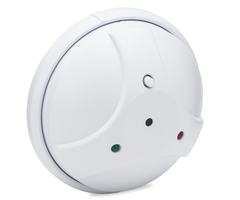
|
2GIG eSeries
|
2GIG GC3e
|
350 Nominal Feet
|
2GIG eSeries Encryption
|
Encrypted glass break sensor for 2GIG.
|
Honeywell 5853

|
Honeywell 5800 Series
|
Lyric, GC3e, 345 MHz IQ2+
|
200 Nominal Feet
|
None
|
Non-encrypted glass break sensor for 345 MHz systems.
|
Qolsys IQ Glass-S

|
Qolsys S-Line
|
319.5 MHz IQ2+
|
600 Feet Open Air
|
Qolsys S-Line Encryption
|
Encrypted glass break sensor for 319.5 MHz systems.
|
Reach Out to Us!

Remember that you can reach out to us with any questions you might have about planning your system and determining sensor compatibility. The best way to contact us is to email support@alarmgrid.com. This is also a good email to use if you are interested in starting new alarm monitoring service with Alarm Grid. Our team checks for new email from 9am to 8pm ET M-F. We look forward to hearing from you!




 Now that you know some basics that apply to almost all wireless sensors, let's start talking about specific types and models. Door and window sensors will let a system know when a door or window has been opened or closed. These are some of the most basic and easy to use sensors on a security system. These devices work by using a larger sensor portion and a smaller magnet portion. The sensor is placed on or inside the door or window frame, and the magnet is placed on or inside the moving portion of the door or window. When the door or window is opened, the magnet will move away from the sensor. This will trip a metal reed switch inside the sensor, which will tell the sensor to alert the system to the opened door or window. All of the sensors we've listed here follow that same method of operation.
Now that you know some basics that apply to almost all wireless sensors, let's start talking about specific types and models. Door and window sensors will let a system know when a door or window has been opened or closed. These are some of the most basic and easy to use sensors on a security system. These devices work by using a larger sensor portion and a smaller magnet portion. The sensor is placed on or inside the door or window frame, and the magnet is placed on or inside the moving portion of the door or window. When the door or window is opened, the magnet will move away from the sensor. This will trip a metal reed switch inside the sensor, which will tell the sensor to alert the system to the opened door or window. All of the sensors we've listed here follow that same method of operation.





























